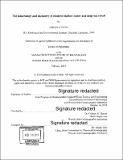| dc.contributor.advisor | Colleen M. Hansel. | en_US |
| dc.contributor.author | Farfan, Gabriela A.(Gabriela Aylin) | en_US |
| dc.contributor.other | Joint Program in Oceanography/Applied Ocean Science and Engineering. | en_US |
| dc.contributor.other | Massachusetts Institute of Technology. Department of Earth, Atmospheric, and Planetary Sciences. | en_US |
| dc.contributor.other | Woods Hole Oceanographic Institution. | en_US |
| dc.date.accessioned | 2019-09-26T19:53:45Z | |
| dc.date.available | 2019-09-26T19:53:45Z | |
| dc.date.copyright | 2019 | en_US |
| dc.date.issued | 2019 | en_US |
| dc.identifier.uri | https://hdl.handle.net/1721.1/122323 | |
| dc.description | Thesis: Ph. D., Joint Program in Oceanography/Applied Ocean Science and Engineering (Massachusetts Institute of Technology, Department of Earth, Atmospheric, and Planetary Sciences; and the Woods Hole Oceanographic Institution), 2019 | en_US |
| dc.description | Cataloged from PDF version of thesis. | en_US |
| dc.description | Includes bibliographical references. | en_US |
| dc.description.abstract | The architecture of coral reef ecosystems is composed of coral skeletons built from the mineral aragonite (CaCO3). Coral reefs are currently being threatened by ocean acidification (OA), which may lower calcification rates, reduce skeletal density, and increase aragonite dissolution. Crystallography and chemistry are what govern the materials properties of minerals, such solubility and strength. Thus, understanding the mineralogical nature of coral aragonite and how it forms are important for predicting bulk skeletal responses under climate change. Different models based on geochemical versus biological controls over coral skeleton biomineralization propose conflicting predictions about the fate of corals under OA. Rather than investigating the mechanism directly, I use a mineralogical approach to study the aragonite end-products of coral biomineralization. | en_US |
| dc.description.abstract | I hypothesize that coral mineralogy and crystallography will lend insights into how coral aragonite crystals form and how sensitive coral aragonite material properties may be to OA. Here I compare the crystallography, bonding environments, and compositions of coral aragonite with aragonite produced by other organisms (mollusk), synthetically (abiogenic precipitation in aragonite-supersaturated seawater and freshwater), and in natural geological settings (abiogenic). Coral aragonite crystallography does not resemble mollusk aragonite (aragonite formed with a strong biological influence), but rather is identical to abiogenic synthetic aragonite precipitated from seawater. I predict that the material properties of coral aragonite are similar to that of abiogenic synthetic seawater aragonites and that coral aragonite formation is sensitive to surrounding seawater chemistry. | en_US |
| dc.description.abstract | To test the effect OA on coral aragonites, I studied deep-sea corals from a natural [omega][subscript sw], gradient (1.15-1.44) in the Gulf of Mexico and shallow-water corals across a natural [omega][subscript sw] (2.3-3.7) and pH (7.84-8.05) gradient in Palau. Minor shifts in crystallography are expressed by coral aragonite in these natural systems, likely governed by skeletal calcite contents, density, and [omega] of the coral calcifying fluid. My results are most consistent with a geochemical model for biomineralization, which implies that coral calcification may be sensitive to OA. However, further work is required to determine whether the modest crystallographic shifts I observe are representative on a global scale and whether they could influence bulk skeletal material properties. | en_US |
| dc.description.statementofresponsibility | by Gabriela A. Farfan. | en_US |
| dc.format.extent | 214 pages | en_US |
| dc.language.iso | eng | en_US |
| dc.publisher | Massachusetts Institute of Technology | en_US |
| dc.rights | MIT theses are protected by copyright. They may be viewed, downloaded, or printed from this source but further reproduction or distribution in any format is prohibited without written permission. | en_US |
| dc.rights.uri | http://dspace.mit.edu/handle/1721.1/7582 | en_US |
| dc.subject | Joint Program in Oceanography/Applied Ocean Science and Engineering. | en_US |
| dc.subject | Earth, Atmospheric, and Planetary Sciences. | en_US |
| dc.subject | Woods Hole Oceanographic Institution. | en_US |
| dc.subject.lcsh | Corals. | en_US |
| dc.subject.lcsh | Deep sea corals. | en_US |
| dc.subject.lcsh | Mineralogy. | en_US |
| dc.subject.lcsh | CoralsEcology. | en_US |
| dc.subject.lcsh | CoralsComposition. | en_US |
| dc.subject.lcsh | CoralsAnatomy. | en_US |
| dc.subject.lcsh | CoralsGrowth. | en_US |
| dc.title | The mineralogy and chemistry of modern shallow-water and deep-sea corals | en_US |
| dc.type | Thesis | en_US |
| dc.description.degree | Ph. D. | en_US |
| dc.contributor.department | Joint Program in Oceanography/Applied Ocean Science and Engineering | en_US |
| dc.contributor.department | Massachusetts Institute of Technology. Department of Earth, Atmospheric, and Planetary Sciences | en_US |
| dc.contributor.department | Woods Hole Oceanographic Institution | en_US |
| dc.identifier.oclc | 1102054498 | en_US |
| dc.description.collection | Ph.D. Joint Program in Oceanography/Applied Ocean Science and Engineering (Massachusetts Institute of Technology, Department of Earth, Atmospheric, and Planetary Sciences; and the Woods Hole Oceanographic Institution) | en_US |
| dspace.imported | 2019-09-26T19:53:45Z | en_US |
| mit.thesis.degree | Doctoral | en_US |
| mit.thesis.department | EAPS | en_US |
